Mercedes S320 1998, S 500 1998 User Manual
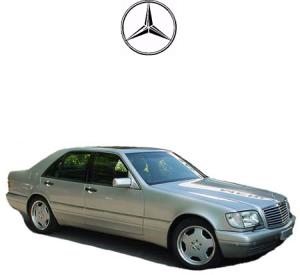
Mercedes-Benz
Operator's Manual
S 320
S 420
S 500
1
Product information
Kindly observe the following in your own best interest:
We recommend using Mercedes-Benz original parts as well as conversion parts and accessories explicitly approved by us for your vehicle model. We have tested these parts to determine their reliability, safety and their special suitability for MercedesBenz vehicles.
We are unable to make an assessment for other products and therefore cannot be held responsible for them, even if in individual cases an official approval or authorization by governmental or other agencies should exist. Use of such parts and accessories could adversely affect the safety, performance or reliability of your vehicle. Please do not use them. Mercedes-Benz original parts as well as conversion parts and accessories approved by us are available at your authorized Mercedes-Benz Center where you will receive comprehensive information, also on permissible technical modifications, and where proper installation will be performed.
Our company and staff congratulate you on the purchase of your new Mercedes-Benz.
Your selection of our product is a demonstration of your trust in our company name. Further, it exemplifies your desire to own an automobile that will be as easy as possible to operate and provide years of service.
Your Mercedes-Benz represents the efforts of many skilled engineers and craftsmen. To ensure your pleasure of ownership, and for your safety and that of your passengers, we ask you to make a small investment of your time:
•Please read this manual carefully before putting it aside. Then return it to your vehicle where it will be handy for your reference.
•Please abide by the recommendations contained in this manual. They are designed to acquaint you with the operation of your Mercedes-Benz.
•Please abide by the warnings and cautions contained in this manual. They are designed to help improve the safety of the vehicle operator and occupants.
•
We extend our best wishes for many miles of safe, pleasurable driving.
DaimlerChrysler AG
2
Operator's manual
This Operator's Manual contains a great deal of useful information.
We urge you to read it carefully and familiarize yourself with the vehicle before driving.
For your own safety and longer service life of the vehicle, we urge you to follow the instructions and warnings contained in this manual. Ignoring them could result in damage to the vehicle or personal injury to you or others. Vehicle damage caused by failure to follow instructions is not covered by the Mercedes-Benz Limited Warranty.
Your vehicle may have some or all of the equipment described in this manual. Therefore, you may find explanations for optional equipment not installed in your vehicle. If you have any questions about the operation of any equipment, your authorized MercedesBenz Center will be glad to demonstrate the proper procedures.
Owner’s Service and Warranty Policy
The Owner’s Service and Warranty Information Booklet contains detailed information about the warranties covering your Mercedes-Benz, including:
•New Car Limited Warranty,
•Emission System Warranty,
•Emission Performance Warranty,
•State Warranty Enforcement Laws (Lemon Laws).
3
Important notice for California retail buyers of Mercedes-Benz automobiles
Under California law you may be entitled to a replacement of your vehicle or a refund of the purchase price, if Mercedes-Benz USA,LLC or its authorized Mercedes-Benz Center fails to conform the vehicle to its express warranties after a reasonable number of repair attempts during the period of one year or 12 000 miles from original delivery of the vehicle. A reasonable number of repair attempts is presumed for a retail buyer (1) if the vehicle is out of service by reason of repair of substantial nonconformities for a cumulative total of more than 30 calendar days or (2) the same substantial non-conformity has been subject to repair four or more times and you have at least once directly notified us in writing of the need to repair the non-conformity and have given us an opportunity to perform the repair ourselves. Notifications should be sent to the nearest Mercedes-Benz Regional Office listed in the Service and Warranty Information Booklet.
Maintenance
The Service Booklet describes all the necessary maintenance work which should be performed at regular intervals. Always have the Service Booklet with you when you take the vehicle to your authorized Mercedes-Benz Center for service. The service advisor will record each service in the booklet for you.
Roadside assistance
The Mercedes-Benz Roadside Assistance Program provides factory trained technical help in the event of a breakdown. Calls to the toll-free Roadside Assistance number:
1-800-222-0100 (in the USA) only
will be answered by Mercedes-Benz Client Assistance Representatives 24 hours a day, 365 days a year.
For additional information refer to the Mercedes-Benz Roadside Assistance Program brochure in your glove box.
4
Change of address or ownership
If you change your address, be sure to send in the "Change of Address Notice" found in the Owner's Service and Warranty Policy Booklet. It is in your own interest that we can contact you should the need arise.
If you sell your Mercedes, please leave all owner's literature with the vehicle to make it available to the next owner.
If you bought this vehicle used, be sure to send in the "Notice of Purchase of Used Car" found in the Owner's Service and Warranty Policy Booklet.
Operating your vehicle outside the USA or Canada
If you plan to operate your vehicle in foreign countries, please be aware that service facilities or replacement parts may not be readily available.
Certain Mercedes-Benz models are available for delivery in Europe under our European Delivery Program. For details, consult your authorized Mercedes-Benz dealer or write to:
In the USA: |
In Canada: |
Mercedes-Benz USA, |
Mercedes-Benz Canada, Inc. |
LLC European Delivery Department |
European Delivery Department |
One Mercedes Drive |
849 Eglinton Avenue East |
Montvale, NJ 07645 |
Toronto, Ontario M4G 2L5 |
5
We continuously strive to improve our product, and ask for your understanding that we reserve the right to make changes in design and equipment. Therefore, information, illustrations and descriptions in this Operator's Manual might differ from your vehicle.
Optional equipment is also described in this manual, including operating instructions wherever necessary. Since they are special-order items, the descriptions and illustrations herein may vary slightly from the actual equipment of your vehicle.
If there are any equipment details that are not shown or described in this Operator's Manual, your authorized MercedesBenz Center will be glad to inform you of correct care and operating procedures.
The Operator's Manual and Service Booklet are important documents and should be kept with the vehicle.
6
Check Regularly and Before a Long Trip
See Index
The First 1000 Miles (1500 km)
The more cautiously you treat your vehicle during the break-in period, the more satisfied you will be with its performance later on. Therefore, drive your vehicle during the first 1500 km (1000 miles) at moderate vehicle and engine-speeds.
During this period, avoid heavy loads (full throttle driving) and high RPM (no more than 2/3 of maximum permissible speed in each gear as indicated on the speedometer).
Avoid accelerating by kickdown. It is not recommended to brake the vehicle by manually shifting to a lower gear. We recommend to select positions "3" or "2"only at moderate speeds (for hill driving).
After 1000 miles (1500 km) speeds may be gradually increased to the permissible maximum
Maintenance
We strongly recommend that you have your vehicle serviced by your authorized Mercedes-Benz dealer, in accordance with the Maintenance Booklet.
Failure to have the vehicle maintained in accordance with the Maintenance Booklet may result in vehicle damage not covered by the Mercedes-Benz Limited Warranty.
Radio Transmitters
Warning!
Never operate radio transmitters equipped with a built-in or attached antenna (i.e. without the telephone connected to an external antenna) from inside the vehicle while the engine is running. Doing so could lead to a malfunction of the vehicle's electronic system, possibly resulting in an accident and personal injury.
Radio transmitters, such as a portable telephone or a citicens band unit should only be used inside the passenger compartment, if they are connected to a Mercedes-Benz approved antenna that is installed on the outside of the vehicle.
7
Introduction |
|
Radio Frequency Infrared Remote Control |
29 |
Interior Lighting |
66 |
Product information |
2 |
Doors |
33 |
Storage Compartments |
67 |
Central Locking Switch |
34 |
First Aid Kit |
68 |
||
Operator's manual |
4 |
Trunk |
35 |
Stowing Things in the Vehicle |
69 |
Consumer Information |
153 |
Power Window and Sliding/Pop-Up Roof |
36 |
Ashtrays |
69 |
Problems with your vehicle |
154 |
Power Closing Ass. f Door and Trunk lid |
37 |
Lighter |
69 |
Reporting Safety Defects |
155 |
Anti-Theft Alarm System |
38 |
Sliding /Pop-up Roof |
70 |
Index |
158 |
Power Seats, Front |
39 |
Power Windows |
71 |
Instruments and controls |
|
Lumbar Support |
42 |
Rear Window Sunshade |
73 |
|
Multicontour Backrest |
42 |
Trunk Lid Release switch |
73 |
|
Instruments and controls |
10 |
Armrest, Front |
43 |
Shelf Below Rear Window |
73 |
Heated Seats |
44 |
Instrument Lamps |
74 |
||
Instrument Cluster |
12 |
Power Seats, Rear |
45 |
Display Illumination |
74 |
Indicator Lamp Symbols |
13 |
Armrest, Rear |
46 |
Trip Odometer |
74 |
Catalytic Converter |
15 |
Head Restraints, Rear |
46 |
Clock |
74 |
Starting and Turning Off the Engine |
16 |
Power Head Restraints, Rear |
47 |
Garage Door Opener |
75 |
Driving Instructions |
17 |
Adjustable Steering Wheel |
48 |
Antenna |
76 |
Operation |
|
Seat belts and Supplemental |
49 |
Cellular telephone |
76 |
|
Restraint system (SRS) |
Driving |
|
||
Automatic Climate Control |
22 |
Seat belts |
49 |
|
|
Baby Smart Airbag System |
52 |
Drinking and driving |
78 |
||
Basic Setting – Automatic Mode |
24 |
Deactivation |
|||
Defogging Windows |
24 |
Self Test |
53 |
Parking Brake |
78 |
Defrosting |
24 |
Emergency tensioning retractor(ETR) |
53 |
Driving off |
78 |
Rear Window Defroster |
24 |
Airbag |
54 |
Automatic Transmission |
79 |
Air circulation |
25 |
Child Restraint |
57 |
Cruise Control |
83 |
Activated Charcoal Control |
26 |
Steering lock |
59 |
Parking Assist (Parktronic) |
85 |
Rear passenger compartment |
27 |
Combination Switch |
60 |
Charge Indicator Lamp |
88 |
Adjustable Air Outlet |
Exterior Lamp Switch |
62 |
Engine Oil Pressure Gauge |
88 |
|
Climate Control |
27 |
Night Security Illumination |
63 |
Low Engine Oil Level Warning Lamp |
|
Car keys |
28 |
Inside Rear View Mirror |
63 |
Engine Oil Consumption |
89 |
Start Lock-out |
29 |
Exterior Rear View Mirror |
63 |
Fuel Consumption Gauge |
89 |
Central Locking System |
29 |
Sun Visors |
65 |
Fuel Reserve and Fuel Cap |
89 |
|
|
Vanity mirrors |
65 |
Placement Warning Lamp |
89 |
8
Outside Temperature Indicator |
90 |
Checking Engine Oil Level |
108 |
Technical Data. Fuels, |
|
|
Tachometer |
90 |
Automatic Trans. Fluid Level |
109 |
Coolants, Lubricants etc. Consumer |
|
|
Coolant Temperature Gauge |
90 |
Spare Wheel |
109 |
Information |
|
|
Low Engine Coolant Level |
91 |
Trunk Lamp |
109 |
Identification Plates |
|
140 |
Warning Lamp |
Vehicle Jack |
110 |
|
|||
Low Windshield and Headlamp |
|
Vehicle Tools |
110 |
Warranty Coverage |
S 320 |
141 |
Washer Fluid Level Warning |
91 |
Storage compartment below vehicle |
110 |
Technical Data |
142 |
|
Lamp |
tool box |
|
S 420 |
144 |
||
Exterior Lamp Failure Indicator |
92 |
Wheels |
111 |
|
S 500 |
146 |
Lamp |
Changing Wheels |
112 |
Fuels, Coolants, Lubricants etc. |
148 |
||
Brake Pad Wear Indicator Lamp |
92 |
Tire in Inflation Pressure |
115 |
Capacities |
|
148 |
Brake Warning Lamp |
93 |
Exterior Lamps |
116 |
Engine Oils |
|
150 |
Flexible Service System (FSS) |
93 |
Battery |
124 |
Engine Oils Additives |
150 |
|
Antilock Brake System (ABS) |
95 |
Fuses |
125 |
Air Conditioner Refrigerant |
150 |
|
Brake Assist System (BAS) |
96 |
Jump Starting |
125 |
Brake Fluid |
|
150 |
Acceleration Slip Regulation (ASR) |
97 |
Towing the Vehicle |
127 |
Premium Unleaded Gasoline |
150 |
|
Electronic Stability program (ESP) |
99 |
Cleaning and Care of the Vehicle |
128 |
Fuel Requirements |
|
151 |
Adaptive damping system (ADS) |
101 |
Testing Infrared Remote Control |
132 |
Gasoline Additives |
|
151 |
Emission Control |
102 |
Front Head Restraints |
133 |
Coolants |
|
152 |
On-Board Diagnostic System |
102 |
Rear Seat Cushion |
134 |
Service and Literature |
163 |
|
Traveling Abroad |
103 |
Emergency Operation of Sliding Roof |
134 |
Check Regularly Before a long Trip |
164 |
|
Winter Driving |
103 |
Replacing Wiper Blades |
135 |
|
|
|
Snow Chains |
103 |
Manual Closing of Trunk Lid |
136 |
|
|
|
Practical Hints |
|
Manual Release of Fuel Filler Flap |
136 |
|
|
|
|
Roof Rack |
137 |
|
|
|
|
Hood |
106 |
Layout of Poly-V-Belt Drive |
137 |
|
|
|
MERCEDES-BENZ |
138 |
|
|
|
||
Checking Coolant Level |
107 |
Spare Part Service |
|
|
|
|
Adding Coolant |
107 |
|
|
|
|
|
9
Instruments and Controls For more detailed descriptions see Index |
|
||
1 |
Left Front Parktronic warning indicator |
21 |
Storage/eyeglasses compartment |
2 |
Side air outlet, adjustable |
22 |
Lock for storage/eyeglasses compartment and eye glove |
3 |
Exterior lamp switch |
23 |
Glove box (illuminated with key in steering lock position 1 or 2) |
4 |
Parking brake release |
24 |
Switch for rear seat head restraints |
5 |
Hood lock release |
25 |
Trunk lid release switch |
6 |
Parking brake pedal |
26 |
Central locking switch, Indicator for anti-theft alarm system |
7 |
Steering wheel adjustment switch |
27 |
Hazard warning flasher switch |
8 |
Combination switch |
28 |
Automatic climate control, Power window defroster switch |
9 |
|
29 |
Activated charcoal filter switch |
Cruise control |
Radio |
||
10 |
Horn, airbag |
30 |
ASR or ESP control switch |
11 |
Instrument cluster |
31 |
Ashtray with lighter |
12 |
Steering lock with ignition/starter |
32 |
Adaptive damping system adjustment switch |
13 |
Right front Parktronic warning indicator |
33 |
Seat heater switch |
14 |
Center air outlet, adjustable |
34 |
Mirror adjustment switch |
15 |
Heated air supply button - center air outlet |
35 |
Power window switch, front doors |
16 |
Non heated/cooled air supply button - center air outlet |
36 |
Power window safety switch, rear doors |
17 |
Air volume control for left air outlet |
37 |
Airbag Off indicator lamp |
18 |
Air volume control for left center air outlet |
38 |
Power window switches, rear doors |
19 |
Air volume control for right center air outlet |
39 |
Parktronic switch |
20 |
Air volume control for right air outlet |
40 |
Switch for rear window sunshade |
10
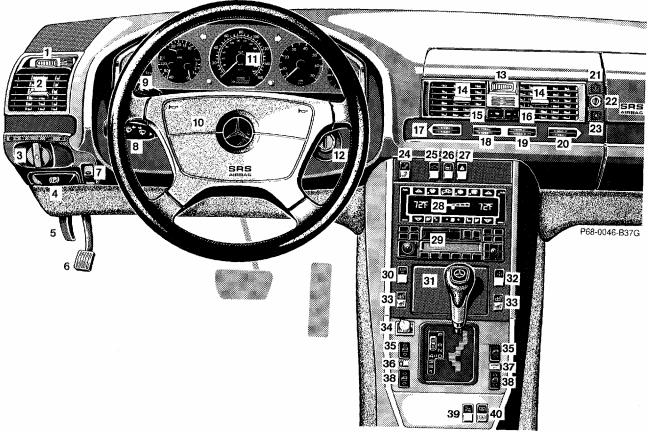
11

|
|
|
|
|
|
Instrument Cluster |
|
|
|
||
1 |
Fuel gauge with reserve and fuel cap placement warning |
8 |
ASR function indicator lamp (yellow). |
||
|
lamp (yellow). See Index |
|
ESP function indicator lamp (yellow). See Index. |
||
2 |
Coolant temperature gauge. See Index |
9 |
Main/trip odometer. See Index |
||
3 |
Fuel consumption gauge. See Index |
10 |
Outside temperature indicator. See Index |
||
4 |
Engine oil pressure gauge (bar). See Index |
11 |
Right turn signal indicator lamp (green) See Index |
||
5 |
Left turn signal indicator lamp (green). See Index |
12 |
Knob for setting clock. See Index |
||
6 |
Knob for instrument lamps and trip odometer and FSS. |
13 |
Tachometer. See Index |
||
|
See Index |
|
|
|
|
7 |
Speedometer See Index |
14 |
Clock. See Index |
||
12
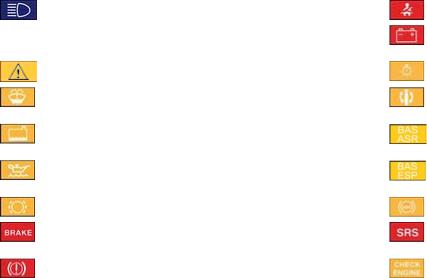
Indicator Lamp Symbols
Function Indicator Lamp
High beam
Warning Lamp
(should go out with the engine running unless)
ESP Adjust driving to road condition. See Index
Fluid level for windshield and headlamp washer system low. See Index.
Coolant level low. See Index.
Engine oil level low. See Index.
Brake pads worn down. See Index.
Brake fluid low (except Canada). Parking brake engaged. See Index.
Brake fluid low (Canada only). Parking brake engaged. See Index.
Fasten seat belts. See Index.
Battery not being charged properly. See Index
Exterior lamp failure. See Index.
ADS malfunction. See Index
BAS malfunction. See Index
ASR malfunction. See Index
BAS malfunction. See Index
ESP malfunction. See Index
ABS malfunction. See Index
SRS malfunction. See Index
Engine malfunction.
If the lamp comes on when the engine is running, it indicates a malfunction of the 02-sensor on Federal version vehicles, and fuel injection system or emission control system on the California version vehicles. In either case, we recommend that you have the malfunction checked as soon as possible. See Index.
13

Additional Function Indicator Lamps
in the Odometer Display
Start Lock-Out malfunction. See Index.
FSS indicator (days). See Index
FSS indicator (distance). See Index
Additional Function Indicator Lamp on the Center Console
Passenger Airbag automatically switched off. See Index
14
Catalytic Converter
Your MERCEDES-BENZ is equipped with monolithic type catalytic converters, an important element in conjunction with the O2 sensor to achieve substantial control of the pollutants in the exhaust emissions. Keep your vehicle in proper operating condition by following our recommended maintenance instructions as outlined in your Maintenance Booklet.
Caution!
To prevent damage to the catalytic converters, use only premium unleaded gasoline in this vehicle.
Any noticeable irregularities in engine operation should be repaired promptly. Otherwise, excessive unburned fuel may reach the catalytic converter causing it to overheat, which could start a fire.
Warning!
As with any vehicle, do not idle, park or operate this vehicle in areas where combustible materials such as grass, hay or leaves can come into contact with the hot exhaust system, as these materials could be ignited and cause a vehicle fire.
15
Starting and Turning Off the Engine
Before Starting
Ensure that parking brake is engaged and that selector lever is in position "P" or "N". Turn key in steering lock to position 2. The charge indicator lamp should come on.
Starting
Do not depress accelerator.
Turn key in steering lock clockwise to the stop. Release key only when the engine is firing regularly.
Important!
Due to the installed starter non-repeat feature, the key must be turned completely to the left before attempting to start the engine again.
Observe the oil pressure gauge immediately after starting the engine. In a very cold engine the oil pressure will rise slowly after the engine has started. Do not speed up the engine before pressure is registered on the pressure gauge. If you do not see the gauge register oil pressure, stop the engine and have it checked.
The charge indicator lamp should go out as soon as the engine has started.
In areas where temperatures frequently drop below -4°F (-20°C) we recommend that an engine block heater be installed. Your authorized Mercedes-Benz dealer will advise you on this subject.
Turning Off
Turn the key in the steering lock to position 0 to stop the engine.
The key can only be removed with the foot off the brake pedal and the selector lever in position "P".
16
Driving Instructions
Warning!
If you feel a sudden significant vibration or ride disturbance, or you suspect that possible damage to your vehicle has occurred, you should turn on the hazard flashers, carefully slow down, and drive with caution to an area which is a safe distance from the roadway.
Inspect the tires and under the vehicle for possible damage. If the vehicle or tires appear unsafe, have it towed to the nearest Mercedes-Benz or tire dealer for repairs.
Power Assistance
When the engine is not running, the brake and steering systems are without power assistance. Under these circumstances, a much greater effort is necessary to stop or steer the vehicle.
Brakes
Warning!
After driving in heavy rain for some time without applying the brakes or through water deep enough to wet brake components, the first braking action may be somewhat reduced and increased pedal pressure may be necessary. Be sure to maintain a safe distance from vehicles in front.
Resting your foot on the brake pedal will cause excessive and premature wear of the brake pads.
It can also result in the brakes overheating thereby significantly reducing their effectiveness. It may not be possible to stop the car in sufficient time to avoid an accident.
The condition of the parking brake system is checked each time the car is in the shop for the required service.
If the parking brake is released and the brake warning lamp in the instrument cluster stays on, the brake fluid level in the reservoir is too low.
Brake pad wear or a leak in the system may be the reason for low brake fluid in the reservoir.
Have the brake system inspected at an authorized Mercedes-Benz dealer immediately.
All checks and maintenance work on the brake system should be carried out by an authorized MERCEDES-BENZ dealer.
Install only brake pads and brake fluid recommended by Mercedes-Benz.
Warning!
If other than recommended brake pads are installed, or other than recommended brake fluid is used, the braking properties of the vehicle can be degraded to an extent that safe braking is substantially impaired. This could result in an accident.
17
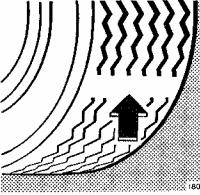
Caution!
When driving down long and steep grades, relieve the load on the brakes by shifting into a lower gear. This helps prevent overheating of the brakes and reduces brake pad wear.
After hard braking, it is advisable to drive on for some time, rather than immediately parking, so the air stream will cool down the brakes faster.
Tires
Tread wear indicators (TWI) are required by law. These indicators are located in six places on the tread circumference and become visible at a depth of approx. 2 mm (1/16 in), at which point the tire is considered worn and should be replaced.
The tread wear indicator appears as a solid band across the tread.
Warning!
Do not allow your tires to wear down too far. With less than 1.5 mm (1/16 in) of tread, the adhesion properties on a wet road are sharply reduced.
Depending upon the weather and/or road surface (conditions), the tire traction varies widely.
Specified tire pressures must be maintained. This applies particularly if the tires are subjected to high loads (e.g. high speeds, heavy loads, high ambient temperatures).
Warning!
Do not drive with a flat tire. A flat tire affects the ability to steer or brake the vehicle. You may lose control of the car. Continued driving with a flat tire or driving at high speed with a flat tire will cause excessive heat build-up and possibly a fire, or tire blowout.
Aquaplaning
Depending on the depth of the water layer on the road, aquaplaning may occur, even at low speeds and with new tires. Avoid track grooves in the road arid apply brakes cautiously in the rain.
18

Tire Traction
The safe speed on a wet, snow covered or icy road is always lower than on a dry road.
You should pay particular attention to the condition of the road as soon as the prevailing temperatures fall close to the freezing point.
Warning!
If ice has formed on the road, tire traction will be substantially reduced. Under such weather conditions, drive, steer and brake with extreme caution.
We recommend M+S rated radial-ply tires for the winter season for all four wheels to insure normal balanced handling characteristics.
On packed snow, they can reduce your stopping distance as compared with summer tires. Stopping distance, however, is still considerably greater than when the road is not snow or ice covered.
Tire Speed Rating
Your vehicle is factory equipped with "H" -rated tires, which have a European speed rating of 130 mph (210 km/h). An electronic speed limiter prevents your vehicle from exceeding the speed rating.
Despite the tire rating, local speed limits should be obeyed. Use prudent driving speeds appropriate to prevailing conditions.
Warning!
Even when permitted by law, never operate a vehicle at speeds greater than the maximum speed rating of the tires.
Exceeding the maximum speed for which tires are rated can lead to sudden tire failure causing loss of vehicle control and resulting in personal injury and possible death.
Parking
Warning!
To reduce the risk of personal injury as a result of vehicle movement, before turning off the engine and leaving the vehicle always:
1.Keep foot on brake pedal.
2.Firmly depress parking brake pedal.
3.Engage first or reverse gear (selector lever position "P" in the case of automatic transmissions).
4.Slowly release brake pedal.
5.Turn front wheels towards the road curb,
6.Turn the key to steering lock position 0 and remove.
7.Take your key and lock vehicle when leaving.
Important!
It is advisable to set the parking brake whenever parking or leaving the vehicle. In addition, engage first or reverse gear (selector lever position "P").
When parking on hills, always set the parking brake.
19
Winter Driving Instructions
The most important rule for slippery or icy roads is to drive sensibly and to avoid abrupt acceleration, braking and steering action. Do not use the cruise control system under such conditions.
When the vehicle is in danger of skidding, declutch, or in case of automatic transmission move selector lever to position "N". Try to keep the vehicle under control by corrective steering action.
Road salts and chemicals can adversely affect braking efficiency. Increased pedal force may become necessary to produce the normal brake effect. We therefore recommend depressing the brake pedal repeatedly when traveling on salt-strewn roads at length. This can bring road salt impaired braking efficiency back to normal. A prerequisite is, however, that this is possible without endangering other drivers on the road.
If the vehicle is parked after being driven on salt treated roads, the braking efficiency should be tested as soon as possible after driving is resumed while observing the safety rules in the previous paragraph.
Warning!
If the vehicle becomes stuck in snow, make sure that snow is kept clear of the exhaust pipe and from around the vehicle with engine running. Otherwise, deadly carbon monoxide (CO) gases may enter vehicle interior resulting in unconsciousness and death.
To assure sufficient fresh air ventilation, open a window slightly on the side of the car that is out of the wind.
Deep Water
Caution!
Do not drive through flooded areas or water of unknown depth.
If you must drive through deep water, drive slowly to prevent water from entering the engine compartment or being ingested by the air intake, possibly causing damage to electrical components or wiring, to engine or transmission that is not covered by the Mercedes-Benz Limited Warranty.
Passenger Compartment
Warning!
Always fasten items being carried as securely as possible.
In an accident, during hard braking or suden maneuvers, loose items will be thrown around inside the vehicle, and cause injury to vehicle occupants unless the items are securely fastened in the vehicle.
20
Operation
21
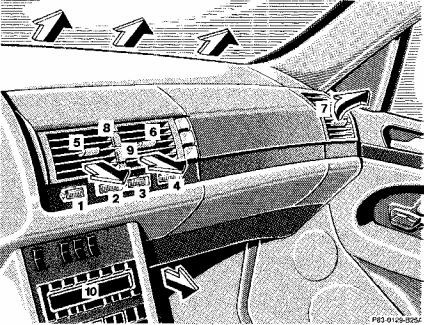
Automatic Climate Control
The system is always at operational readiness, except when manually switched off.
The automatic climate control only operates with the engine running
The temperature selector should be left at the desired temperature setting. The temperature selected is reached as quickly as possible.
The system will not heat or cool any quicker by setting a higher or lower temperature.
1Air volume control for left air outlet, turn left to open
2Air volume control
for left center air outlet, turn left to open
3Air volume control
for right center air outlet, turn left to open
4Air volume control for right air outlet, turn left to open
5Left center air outlet, adjustable
6Right center air outlet, adjustable
7Side air outlet, left and right, adjustable
Push-buttons for center air outlets
8Heated air supply
9Non-heated/cooled air supply Basic mode:
None of the push-buttons (8 or 9) is pressed.
10 Display and Controls
22

Display and Controls
Press to activate, indicator lamp is on while activated.
Automatic mode
Raise temperature
Lower temperature
Defrost
Air recirculation
Activated charcoal filter Rear window defroster Air distribution, manual Economy mode
Air volume, manual
Residual engine heat utilization
The automatic climate control removes considerable moisture from the air during operation in the cooling mode. It is normal for water to drip on the ground through ducts in the underbody.
The desired interior temperature can be selected separately for the left and right side of the passenger compartment.
Important!
This vehicle is equipped with an air conditioner system that uses HFC-134a (ozone-friendly hydro-
fluorocarbon) as a refrigerant. Repairs should always be performed by a qualified technician, and refrigerant should be collected in a recovery system for recycling.
23
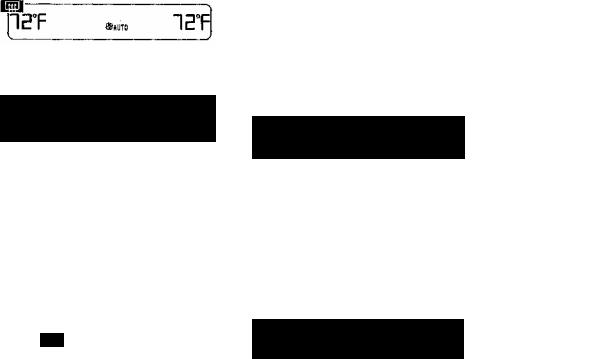
Basic Setting - Automatic Mode
Press left and right |
|
for |
automatic mode. |
|
|
Simultaneously press both
 and
and  for temperature setting of 72°F.
for temperature setting of 72°F.
Air volume and distribution are controlled automatically.
This setting can be used all year around.
Economy
The function of this setting corresponds to the automatic mode. However, because the air conditioning compressor will not engage (fuel savings), it is not possible to air condition in this setting.
Press  button to activate.
button to activate.
Press button once again to return to previous setting.
Special Settings
(use only for short duration)
Defogging Windows
Switch off  button.
button.
Press left and right  buttons.
buttons.
Press  button repeatedly until air is directed upward.
button repeatedly until air is directed upward.
Turn wheels (1 and 4) left to open left and right air outlets (7). Adjust air outlets upward.
Defrosting
Turn wheels (1 and 4) left to open left and right air outlets (7). Adjust air outlets upward.
Press  button once again to return to previous setting.
button once again to return to previous setting.
Press  button. Maximum heated and automatically controlled amount of air is directed to the windshield and side windows.
button. Maximum heated and automatically controlled amount of air is directed to the windshield and side windows.
Rear Window Defroster
Turn key in steering lock to position 2.
To select, press |
|
|
button. |
To cancel, press |
|
|
button again. |
|
|
Note:
Heavy accumulation of snow and ice should be removed before activating the defroster.
The rear window defroster uses a large amount of power. To keep the battery drain to a minimum, turn off the defroster as soon as the window is clear.
The defroster is automatically turned off after a maximum of 12 minutes of operation.
If several power consumers are turned on simultaneously, or the battery is only partially charged, it is possible that the defroster will automatically turn itself off. When this happens, the indicator lamp inside the switch starts blinking.
As soon as the battery has sufficient voltage, the defroster automatically turns itself back on.
24
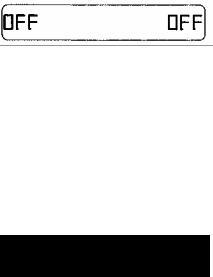
Air Distribution
Press  button repeatedly until the requested symbol is displayed.
button repeatedly until the requested symbol is displayed.
Air Volume
Press - or + side of rocker switch  until the requested blower speed is attained. A choice of 7 blower speeds is available.
until the requested blower speed is attained. A choice of 7 blower speeds is available.
To switch the automatic climate control off, press - side of rocker switch  until symbol OFF is displayed.
until symbol OFF is displayed.
The fresh air supply to the car interior is shut off.
While driving, use this setting only temporarily, otherwise the windshield could fog up.
To switch the automatic climate control on again, press  , or
, or  + side of
+ side of
 .
.
Air Recirculation
This mode can be selected to prevent annoying odors or dust from entering the car's interior.
Outside air is not supplied to the car's interior.
To select, press  button. To cancel, press
button. To cancel, press  button again.
button again.
The system will automatically switch from recirculated air to fresh air
•after approx. 5 minutes at outside temperatures below approx. 40°F (5°C),
•after approx. 30 minutes, at outside temperatures above approx. 40°F (5°C),
•after approx. 5 minutes, if button  is pressed.
is pressed.
Notes:
If the windows should fog up from the inside, switch from recirculated air back to fresh air.
At high outside temperatures, the system automatically engages the recirculated air mode thereby increasing the cooling capacity performance, switching to partially fresh air within 20 minutes.
Dust Filter
Dust particles (down to a certain size) and pollen are filtered out before outside air enters the passenger compartment through the air distribution system.
Notes:
Do not obstruct the air flow by placing objects on the air flow-through exhaust slots below the rear window.
Also keep the air intake grille in front of windshield free of snow and debris.
25

Activated Charcoal Filter
To select, press  button. To cancel, press button again.
button. To cancel, press button again.
An activated charcoal filter markedly reduces bad odors and removes pollutants from the air entering the passenger compartment.
The blower speed is slightly increased to supply a constant volume of air.
The system switches automatically to the air recirculation mode, if the carbon monoxide (CO) or nitric oxide (NOX) of the outside air increases.
When pressing button  or
or
 , the filter is also switched off.
, the filter is also switched off.
Notes:
The automatic air recirculation does not function when selecting the Economy mode , or the outside temperature is below 45°F (7°C).
The activated charcoal filter should be switched off when windows fog up on the inside, or if the passenger compartment needs to be quickly heated or cooled down.
Residual Engine Heat Utilization
With the engine switched off, it is possible to continue heating the interior for a short while.
Air volume and distribution are controlled automatically.
To select:
Turn key in steering lock to position 1 or 0 or remove key. Close air outlet in rear passenger compartment.
Press  button.
button.
This function selection will not activate if the battery charge level is insufficient.
To cancel:
Press  button.
button.
The system will automatically shut off
•if you turn key in steering lock to position 2,
•after approx. 30 minutes,
•if the battery voltage drops.
26

Rear Passenger Compartment
Adjustable Air Outlet
Vehicles without rear passenger compartment climate control.
Slide switch (1) up to open outlet for fresh/cooled air only.
The air outlet is adjustable.
Rear Passenger Compartment
Climate Control
1Temperature selector, left side
2Temperature selector, right side
A basic setting in the white field of the selector is recommended.
3 Air volume selector
The air volume can be varied continuously. The air flow is switched off with selector in position "0".
4Adjustable air outlet, left side
5Adjustable air outlet, right side
6Air distribution slide
Top position: air flow from air outlets (4 and 5).
Bottom position: air flow from air outlets beneath front seats. Intermediate positions can be selected for a mixed air flow.
Note:
The rear passenger climate control does not operate with automatic climate control in mode or switched off with the air volume control  .
.
27

Car Keys
Included with your vehicle are
•2 remote controls with folding master keys,
•1 Valet key,
•1 Flat key.
Infrared Remote Control with Folding Master Key
The master key fits all locks on the car. To release the key, press button (1). The key unfolds from the holder by itself.
The transmitter for the infrared remote control is located in the key holder.
The infrared receivers are located in the door front handles.
The valet key works only in the driver's door lock and the steering lock.
The valet key will not work in the trunk and storage compartments locks.
The flat key fits all locks on the Car.
Notes:
Do not give the master key to an unauthorized person.
We recommend that you carry the flat key with you and keep it in a safe place (e.g. your wallet) so that it is always handy. Never leave the flat key in the vehicle.
Warning!
When leaving the vehicle always remove the key from the steering lock. Do not leave children unattended in the vehicle. Unsupervised use of vehicle equipment may cause serious personal injury.
Obtaining Replacement Keys
Your vehicle is equipped with a theft deterrent locking system requiring a special key manufacturing process. For security reasons, replacement keys can only be obtained from your authorized Mercedes-Benz dealer.
28
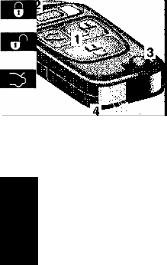
Starter Lock-Out
Important!
Removing the key from the steering lock activates the start lock-out. The engine cannot be started.
Turning the key in the steering lock to position 2 deactivates the start lock-out.
Note:
In case the engine cannot be started, and the message START-ERROR shows in the odometer display field, the system is not operational. Contact an authorized Mercedes-Benz dealer or call 1-800-FOR-MERCedes.
Central Locking System
Radio Frequency and Infrared
Remote Control
The master key has an integrated radio frequency and infrared remote control.
Due to the extended operational range of the remote control, it could be possible to unintentionally lock or unlock the vehicle by pressing the transmit button.
The vehicle doors, trunk and fuel filler flap can be centrally locked and unlocked.
Closing the windows and sliding/popup roof can only be done with the infrared portion of the remote control. Aim transmitter eye (4) at a receiver (5 or 6) and press transmit button.
With vehicle centrally locked, the trunk can also be opened by using the remote control.
If the key is inserted in steering lock, the vehicle cannot be locked or unlocked with the remote control.
1 Transmit button
Locking
Unlocking
Opening trunk
(if not key locked)
2PANIC button
3Key release button
4Lamp for battery check and transmitter eye
29
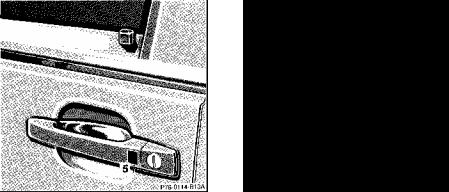
5Infrared receiver in driver's door handle
6Infrared receiver in front passenger door handle
Locking and Unlocking
Unlocking:
Press transmit button  . All turn signal lamps blink once to indicate that the vehicle is unlocked.
. All turn signal lamps blink once to indicate that the vehicle is unlocked.
The remote control can be programmed for two kinds of unlocking methods (see below):
Selective unlocking mode - Press transmit button  once to unlock driver's door and fuel filler flap.
once to unlock driver's door and fuel filler flap.
Press transmit button  twice to unlock doors, fuel filler flap, and trunk. Global unlocking mode-Press transmit button
twice to unlock doors, fuel filler flap, and trunk. Global unlocking mode-Press transmit button  once to unlock doors, fuel filler flap, and trunk.
once to unlock doors, fuel filler flap, and trunk.
Notes:
If the trunk was previously locked separately, it will remain locked (see Index).
The presently active unlocking mode (selective or global) can only be determined by unlocking the vehicle with the remote control (see below for changing mode).
30
